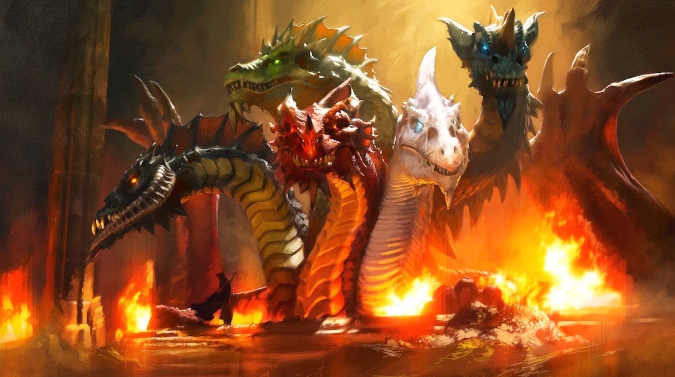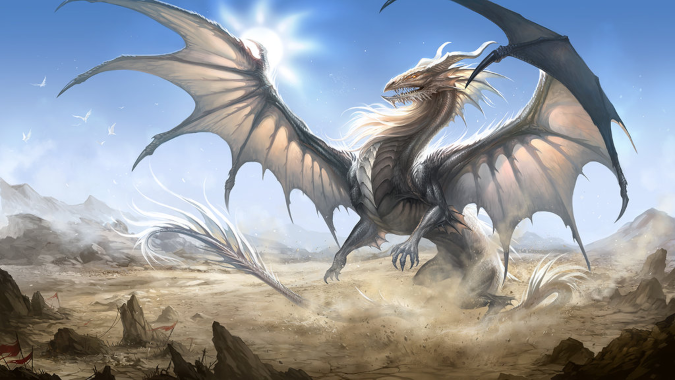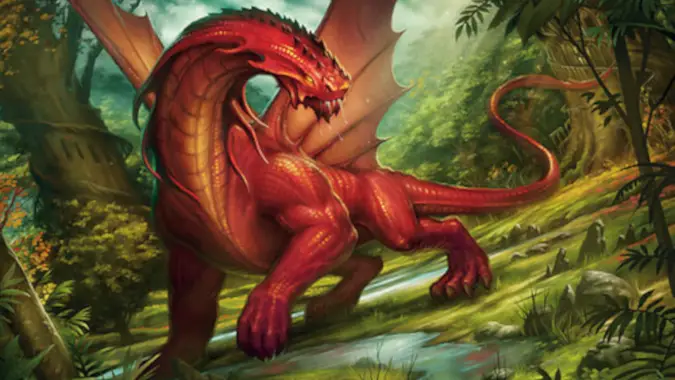Fizban’s Treasury of Dragons brings more Dragons, more ways to use them, and hints of their cosmic importance

Fizban’s Treasury of Dragons is a new sourcebook for Dungeons and Dragons 5e, and it’s all about Dragons. We apologize if letting you know the Dragon book is about Dragons spoiled it for you.
While I’d also like a copy of Acererak’s Guide to Dungeons while we’re at it — completing both the Dungeons and Dragons halves of Dungeons and Dragons — what we get in Fizban’s is pretty amazing. It lays the foundation for Wizards of the Coast’s new iteration of the multiverse idea, with Dragons serving as a key touchstone to and aspect of the material plane, and the Dragon Gods Tiamat and Bahamut as forces of divinity wholly of said plane and responsible for its creation — or at least that’s their story. It also gives Dragons the ability to see into other realities and even exist on multiple worlds at once in different incarnations.

The Death of the First World and how Dragons made everything
While this is extremely metaphysical, what it boils down to is the idea that you can use any Dragon — from any world or setting for D&D — in your own campaign. You’re not playing a Krynn campaign, but you want to use Cyan Bloodbane in your new adventure for your party? Go for it. He’s still the same treacherous, poisonous, malevolent force he was in the Dragonlance series — he’s just your setting’s version of the Dragon. Even if your players kill him he can always pop up later if they go to Krynn. He’ll even potentially know who they are, and that they killed another version of him out in the multiverse.
Some of these Dragons, known as Greatwyrms, are so powerful that they’re almost seen as gods — and if you’re wondering where your favorite Dragon deities from previous editions of D&D are, they’ve likely been converted to Greatwyrm status and serve, less as Dragon gods, and more like intensely powerful Dragons that span multiple plains of existence at once and can see into other realities.
Yes, in this book, Dragons are now living in the pre-Crisis DC universe and can have team ups with, and/or fights with, other universe versions of themselves, and if you don’t get that reference trust me you’re better off. But the idea is really intriguing — Ashardalon, for example, the villainous Red Dragon from the 3e modules The Sunless Citadel and Bastion of Broken Souls is now the Dragon version of Jet Li from The One, literally consuming other versions of himself to become a terrifying threat to multiple worlds at once.

Dragons, Dragons, and more Dragons
The book expands the kinds of Dragons one might face. Both the Chromatic Dragons — the White, Blue, Black, Green, and Red that more often than not serve Tiamat — and the Metallic Dragons under Bahamut — Brass, Bronze, Copper, Silver, and Gold — are represented here. There are also the Gem Dragons, descendants of Sardior, the Ruby Dragon and first offspring of Bahamut and Tiamat. These are the Amethyst, Crystal, Emerald, Sapphire, and Topaz Dragons. There are also Dragons like the Deep, Moonstone, and even the Dragon Turtle, which neither Bahamut or Tiamat seem to want to take credit for.
One of the really interesting lore changes in this book is the idea that even Bahamut and Tiamat, while seen as gods by most mortals, don’t see themselves as gods in the same way that the various divinities from the Outer Planes are seen as gods. To Dragons, they’re just considered the most powerful of their kind — there’s no ontological difference between, say, Aasterinian or Chronolepsis as Greatwyrms respected and emulated by other Dragons, and Tiamat, or Bahamut. Dragons don’t pray, not even to these most powerful elder Dragons, and so technically even the Dragon gods aren’t gods. They’re just potentially immortal beings with a fundamental connection to the baseline reality of the material plane, able to summon vast elemental powers from their existence in said plane, and sometimes capable of communicating with, or even consuming alternate versions of themselves from other realities. They can grow so powerful that they can even grant spells to beings that venerate them — not godlike at all.

Gods? We’re Dragons, we’re already better than everything
This is an extremely useful adventure hook, because it means that Dragons can be doing all sorts of things for reasons that would make literally no sense if you didn’t know about other realities.
Let’s say you come across a Dragon who has built an elaborate mountain citadel full of servants and allies who are really good at killing not just Dragons, but the specific kind of Dragon that they are themselves serving. This might seem like a really strange thing to do, until you find out that this particular Dragon is this world’s version of Ashardalon, the Red Dragon Greatwyrm who has already consumed several other aspects of itself and is now plotting to do the same here. You probably won’t find that out until you’ve carved your way through much of your Ashardalon’s defenses, wherein you find out the kindly old sage who helped you decode the Dragon tablet and find Ashardalon is in fact an agent for the other, worse Ashardalon, and now with all those specific anti-Dragon defenses and measures destroyed he can just fly in and kill his other self. Thanks, heroes!
In addition to all that, Fizban’s brings us a host of other kinds of Dragons or things related to them in this book for you to use to make your players miserable, or even to empower them. One of my favorites is the reintroduction of Draconians, which long time players will know from the Dragonlance series. Here the Draconians are no longer only created from Metallic Dragon eggs. A sufficiently evil and magically powerful entity could well find a Red Dragon’s clutch of eggs and make any kind of Draconians from it, gaining an army of powerful Dragon-like servitors who explode in a magical holocaust when slain.
The book also contains such — I hesitate to use the word treasures about some of these monsters, but still — treasures as the Elder Brain Dragon, an unfortunate Dragon who is captured by Mind Flayers and has their Elder Brain literally implanted onto their backs. It drives tendrils into the Dragon’s brain and uses it as a mobile command post to spread its influence even further by spitting a breath weapon that contains hundreds of Mind Flayer tadpoles to infest others and transform them into Mind Flayers.
This book is worthwhile for the Bestiary chapter alone, even if you’re not interested in the whole metaphysical aspect of the First World and the war between Dragons and outsider gods from the Outer Planes. Trust me, the first time you drop an Eyedrake on your party, they’re going to remember that session forever. It’s an amazing book, managing to combine the crunchy bits most DMs crave, solid player options like new Dragonborn types and new subclasses, and a lot of lore with heavy implications for Dungeons and Dragons and its future.
Please consider supporting our Patreon!
Join the Discussion
Blizzard Watch is a safe space for all readers. By leaving comments on this site you agree to follow our commenting and community guidelines.
 @MatthewWRossi
@MatthewWRossi




